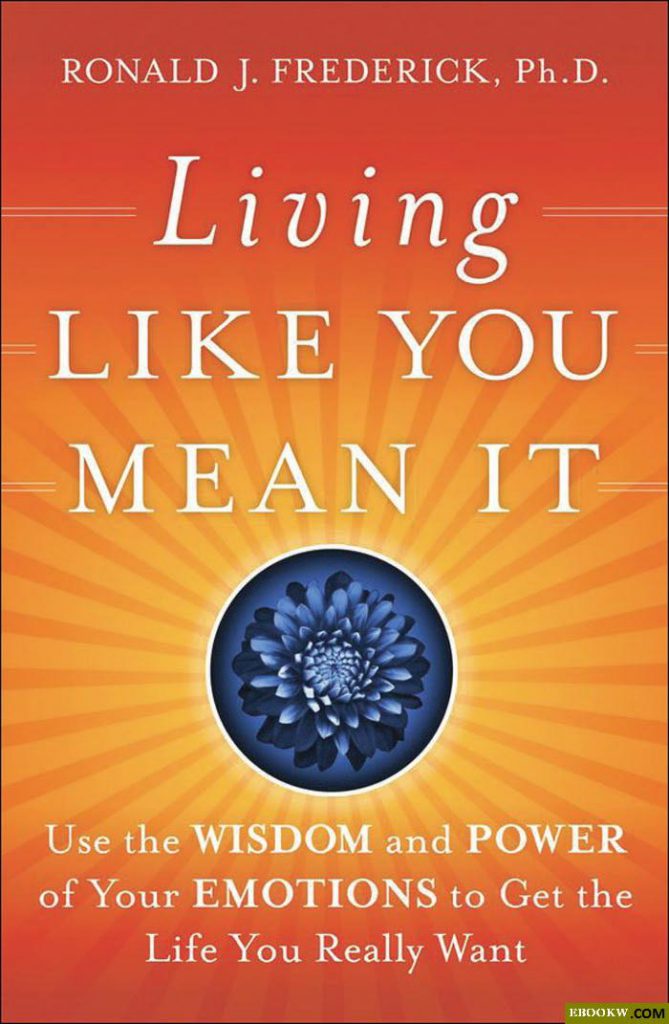 Living Like You Mean it by Ronald Frederick has the most self-helpiest title ever conceived. And good lord, the tag line really drives it home: “Use the WISDOM and POWER of Your EMOTIONS to Get the Life You Really Want”. All it’s missing is eight exclamation points and an accidental “1” at the end. To say the least, if the recommendation hadn’t come from someone who’s opinion I highly respect, I never would have picked it up. I’m a real cover-judger.
Living Like You Mean it by Ronald Frederick has the most self-helpiest title ever conceived. And good lord, the tag line really drives it home: “Use the WISDOM and POWER of Your EMOTIONS to Get the Life You Really Want”. All it’s missing is eight exclamation points and an accidental “1” at the end. To say the least, if the recommendation hadn’t come from someone who’s opinion I highly respect, I never would have picked it up. I’m a real cover-judger.
So now that I’ve thoroughly disclaimed and absolved myself of your judgement, I can go on to say that this book is now on a short-list of very serious perspective shifters. (note to self, make actual list of perspective shifting books). If you’re someone who spends any regular time with me in real life, you’ve probably already heard me parroting concepts I’ve found within these pages, attempting to actually synthesize. But the psychological concepts run deep, and they’re not easily exhausted.
In short, the book describes how the fear of feeling creates elusive problems in people’s lives. People avoid feelings they find unpleasant, but they also often avoid the fear of those feelings, which creates confusion when trying to understand why we act or feel a certain way. For example, someone who has developed a fear of the physical manifestations of anger (and their connected actions), might instead deflate and experience the physical sensations of sadness, as a defensive strategy.
Conceptually, the crux of Frederick’s ideas here rest in two primary concepts. The first, that rationality happens in the neocortex less reflexively than strong emotions (particularly of fear) that happen in the amygdala. The amygdala can send messages directly to the body, bypassing the neocortex. This is why it’s possible to feel afraid when there is rationally nothing to be afraid of. Our rationalizations and our feelings are not directly connected.
The second concept carrying Frederick’s idea is that our rationalizations and our feelings are also not the same thing. The manifestations of emotions in the body, and the rationalizations of them in the mind, neither may be strictly representative of reality. A dead branch in the path, when mistaken for a snake, might cause an unwarranted fear response. The response is real, the circumstance was not.
These points become important throughout the case studies Frederick shares because the nature of the problem makes the solution elusive and these concepts are critical to finding them. Emotions are felt in the body. They are a sensation, like touch, except they originate inside us. To sort ourselves out, we can become aware of how your emotions are existing in your body. While trying to sort ourselves out, we can’t condemn our sensations with our rational mind before they can work themselves out.
Frederick describes our basic emotions like waves, which have a natural foreword motion. They rise, crest, break and disperse. When I think over my experiences with raw emotion that I didn’t attempt to dampen, this feels like it fits. They come, they feel very intense for a short time, then they begin to recede all on their own. Frederick makes one notable exception: When we’re substituting one emotion for a less favorable one. For example, can you think of a time when someone made you really angry first thing in the morning? But you know, it “wasn’t their fault”? I’ve had experiences like that. I’ll talk down the angry feeling with rationalizations about how I shouldn’t be angry at that person or that situation. As a result I will usually find myself depressed for the better part of the day. Other times, when I’ve instead sat down and written out my feelings, or vented those feelings to my dog or a willing neutral party, the feelings dissipate all on their own.
As people, we have a labyrinthian series of protocols to deal with our emotions, but rarely is that method direct and head-on. As a result, we have problems that never seem to end, and solutions that do nothing but shuffle the letters in the word. I can’t say how right, or complete Frederick’s points are, it feels intuitively correct–A corner piece of the puzzle.
For a book that just begs you not to read it, it’s surprisingly enjoyable. Each case study makes Frederick’s concepts easy to understand, and he keeps the subjects vague enough that I was able to relate in some way to each of them. This is a book I will have to come back to again in a few years. I sense that I’ll get something entirely new from it them. It’s also a book I will certainly recommend if you talk to me for long enough.

Recent Discussion